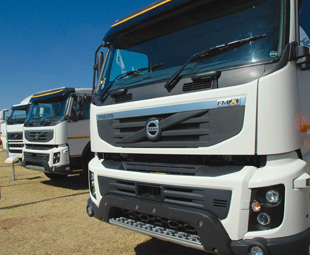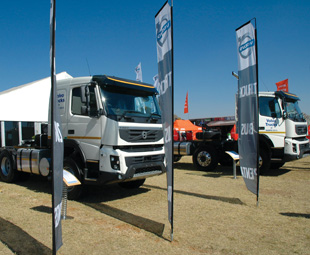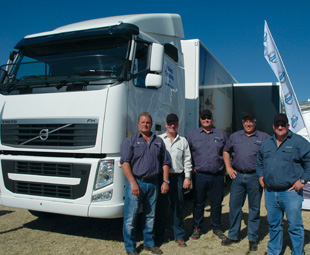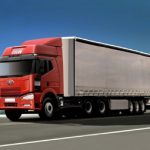Volvo captivates at Nampo

“Technology for sustainable production” – the theme this year at Grain SA’s Nampo Harvest Day – rings true for Volvo Trucks South Africa as its products attracted a lot of attention at the show show.
The annual Nampo Agricultural Trade Show, which took place just outside Bothaville in the Free State, is certainly booming … This year’s event attracted 72 376 attendees, nearly matching 2011’s record-setting number that exceeded 73 000, when a public holiday boosted attendance.
And for Volvo Trucks South Africa, the importance of Grain SA’s Nampo Harvest Day can’t be more apparent. “This isn’t your typical small town show, with a couple of tractors and one or two cattle,” says Theo Stoltz, national truck sales manager for Volvo Trucks Southern Africa. “There are other shows that we choose not to attend so that we can be at Nampo.”
This tells us just how important this agricultural trade show is to the company. “There are a lot of farmers using our products,” Stoltz points out. “But it isn’t only farmers or people in the agricultural industry who attend – a substantial number of transport operators come to the show as well … So we don’t ask the question ‘can we afford to be here’, we ask ‘can we afford not to be here’.”
He adds that Nampo gives Volvo better access to the agricultural community, good exposure to the brand and ensures that its vehicles are top of mind.
The company had an FMX13 400 6×4 truck tractor, an FMX11 370 8×4 rigid truck and an FH13 440 6×4 truck tractor at the show. “Two of the vehicles attracted quite a bit of attention, the FH and the FMX13, and it wasn’t only from people who were asking questions just for the sake of asking,” says Stoltz. And, if you look at the specs of the vehicles, it’s no wonder.
 The FMX range has a gross vehicle mass (GVM) of 18 to 48 tonnes and a chassis height of 900 to 1 240 mm. It has a front towing beam that can handle 25 tonnes and a six-cylinder engine, providing up to 500 hp (372,85 kW). It was designed for heavy construction work, making it ideal for the agricultural industry as it can rough it in any conditions.
The FMX range has a gross vehicle mass (GVM) of 18 to 48 tonnes and a chassis height of 900 to 1 240 mm. It has a front towing beam that can handle 25 tonnes and a six-cylinder engine, providing up to 500 hp (372,85 kW). It was designed for heavy construction work, making it ideal for the agricultural industry as it can rough it in any conditions.
Because one truck is seldom like another, especially in the agricultural industry, the vehicle is, as far as possible, factory-prepared for bodybuilding. The frame is parallel, equally high along its entire length and equipped with modular attachments so that a bodybuilder doesn’t have to make any unnecessary holes. And, when things do get tricky, bodybuilders can get expert help from Volvo’s Bodybuilding Instructions.
The FH13 has a gross combination mass of up to 100 tonnes, with the model on display having a GVM of 43 tonnes. The vehicle can also be made to suit various transport tasks, with its chassis being available in different heights, its different types of suspension, braking systems and peripheral equipment.
But it isn’t all about the mechanical aspects, as Volvo is also renowned for safety. The FH’s cab is available in four variants; the day, sleeper, Globetrotter or Globetrotter XL and meets Swedish cab strength standards – one of the toughest in the world. All very reassuring, especially for operators or farmers driving on narrow roads filled with tractors going at a snail’s pace.
In terms of safety, the primary task of the vehicle’s cab is to transfer the energy of the collision backwards to maintain sufficient survival space for the occupants. Volvo points out that a person’s body is likely to be exposed to power twice that of its weight in a crash – adding that a person weighing 100 kg is exposed to a force equal to four tonnes when travelling at 50 km/h.
This is why the company designed the interior of its cab to be energy-absorbent and to yield to the impact of the human body. All the cabins’ steering wheels and dashboards are energy-absorbent, as are the trims at knee height. Additionally, all upholstery fabrics are made from flameproof materials.
However, Volvo is taking it even further, keeping the environment in mind as well. Around 95 percent of a Volvo truck is recyclable, with 33 percent of its weight already being made from recycled materials.
So these vehicles are proving that they are equipped, safe and green enough to handle anything the agricultural (or any other) industry can throw at them. Volvo Trucks also has some good news for the local market … “The new FH16 750, which was launched in Europe last year, will be launched during October in South Africa,” says Stoltz. The company had banners of the vehicle at its stand and was eager to spread the good news.
 Stoltz says that Volvo Trucks SA has had extremely positive reactions to the new vehicle so far. “The local market is very keen and is waiting in anticipation. People want to know when it is coming.”
Stoltz says that Volvo Trucks SA has had extremely positive reactions to the new vehicle so far. “The local market is very keen and is waiting in anticipation. People want to know when it is coming.”
He adds: “Volvo says that it is the best vehicle it has ever launched, and it’s no cliché. A lot of new technology and R&D have gone into the vehicle. It is a very appealing vehicle and a beautiful truck.”
But visual appeal isn’t the only thing that Volvo upgraded … It added some impressive power to the package as well. The new FH has a whopping 750 hp (559,32 kW) of power and, more importantly, a mindboggling 3 550 Nm of torque. And
90 percent of this is available within seconds!
The engine, however, isn’t the only thing that got pumped up in size as the cabin got bulked up as well. “The cab is almost one cubic metre bigger than the current cab,” Stoltz emphasises, “which is a huge benefit for the driver.”
One can definitely believe Volvo’s statement that the FH16 is the culmination of everything the company knows about trucks – and then some.
However, the good news at Nampo didn’t stop with the FH16 as Stoltz says that the new FM and FMX will also be coming to South Africa’s shores in October. “The vehicles will be available from March or April and we’ll start taking orders in November or December.”
So the wait is nearly over for Volvo’s trucks, which are ideally geared for the farming sector and much more, to be joined by the company’s latest product offering – ensuring that our country’s agricultural industry can provide sustainable production with Volvo’s technology.
Published by
Focus on Transport
focusmagsa




 Big news from FOCUS on Transport + Logist
Big news from FOCUS on Transport + Logist


 !
Starting 1 April, every
!
Starting 1 April, every


 FUSO: Driving the Future of Mobile Healthc
FUSO: Driving the Future of Mobile Healthc



 A brand
A brand




 Wondering about the maximum legal load for a
Wondering about the maximum legal load for a 
 The MAN hTGX powered by a hydrogen combus
The MAN hTGX powered by a hydrogen combus

 Exciting News for South African Operators
Exciting News for South African Operators


